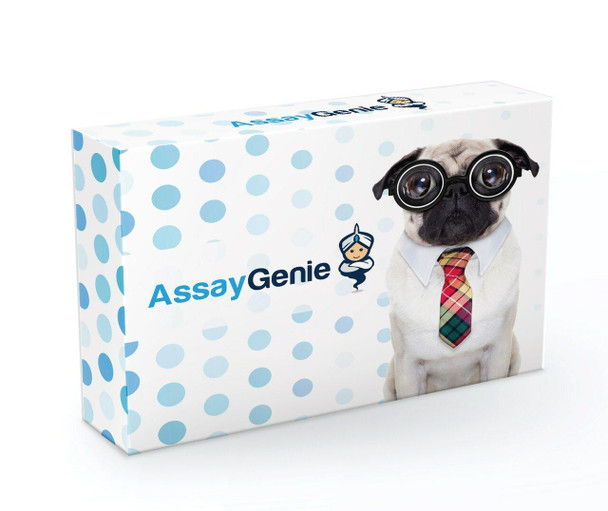Cell Biology Antibodies 7
Anti-RASD2 Antibody (CAB17367)
- SKU:
- CAB17367
- Product Type:
- Antibody
- Reactivity:
- Human
- Host Species:
- Rabbit
- Isotype:
- IgG
- Antibody Type:
- Polyclonal Antibody
- Research Area:
- Cell Biology
Description
| Antibody Name: | Anti-RASD2 Antibody |
| Antibody SKU: | CAB17367 |
| Antibody Size: | 20uL, 50uL, 100uL |
| Application: | WB |
| Reactivity: | Human |
| Host Species: | Rabbit |
| Immunogen: | Recombinant protein of human RASD2. |
| Application: | WB |
| Recommended Dilution: | WB 1:500 - 1:2000 |
| Reactivity: | Human |
| Positive Samples: |
| Immunogen: | Recombinant protein of human RASD2. |
| Purification Method: | Affinity purification |
| Storage Buffer: | Store at -20'C. Avoid freeze / thaw cycles. Buffer: PBS with 0.02% sodium azide, 50% glycerol, pH7.3. |
| Isotype: | IgG |
| Sequence: | Email for sequence |
| Gene ID: | 23551 |
| Uniprot: | Q96D21 |
| Cellular Location: | |
| Calculated MW: | 30kDa |
| Observed MW: | Refer to figures |
| Synonyms: | Rhes, TEM2, MGC:4834, RASD2 |
| Background: | This gene belongs to the Ras superfamily of small GTPases and is enriched in the striatum. The encoded protein functions as an E3 ligase for attachment of small ubiquitin-like modifier (SUMO). This protein also binds to mutant huntingtin (mHtt), the protein mutated in Huntington disease (HD). Sumoylation of mHTT by this protein may cause degeneration of the striatum. The protein functions as an activator of mechanistic target of rapamycin 1 (mTOR1), which in turn plays a role in myelination, axon growth and regeneration. Reduced levels of mRNA expressed by this gene were found in HD patients. |
| UniProt Protein Function: | RASD2: GTPase signaling protein that binds to and hydrolyzes GTP. Regulates signaling pathways involving G-proteins-coupled receptor and heterotrimeric proteins such as GNB1, GNB2 and GNB3. May be involved in selected striatal competencies, mainly locomotor activity and motor coordination. Belongs to the small GTPase superfamily. RasD family. |
| UniProt Protein Details: | Protein type:G protein, monomeric, RasD; G protein; G protein, monomeric Chromosomal Location of Human Ortholog: 22q13.1 Cellular Component: plasma membrane Molecular Function:GTPase activity; GTP binding; ubiquitin conjugating enzyme binding; G-protein beta-subunit binding Biological Process: positive regulation of protein sumoylation; synaptic transmission, dopaminergic; positive regulation of protein kinase B signaling cascade; metabolic process; small GTPase mediated signal transduction; locomotory behavior; negative regulation of protein ubiquitination |
| NCBI Summary: | This gene encodes a Ras-related protein that enriched in striatum. The product of this gene binds to GTP and possesses intrinsic GTPase activity. The gene belongs to the Ras superfamily of small GTPases. The exact function of this gene is unknown, but most striatum-specific mRNAs characterized to date encode components of signal transduction cascades. [provided by RefSeq, Jul 2008] |
| UniProt Code: | Q96D21 |
| NCBI GenInfo Identifier: | 21362868 |
| NCBI Gene ID: | 23551 |
| NCBI Accession: | Q96D21.1 |
| UniProt Secondary Accession: | Q96D21,O95520, Q5THY8, |
| UniProt Related Accession: | Q96D21 |
| Molecular Weight: | 30,366 Da |
| NCBI Full Name: | GTP-binding protein Rhes |
| NCBI Synonym Full Names: | RASD family, member 2 |
| NCBI Official Symbol: | RASD2 |
| NCBI Official Synonym Symbols: | Rhes; TEM2; MGC:4834 |
| NCBI Protein Information: | GTP-binding protein Rhes; tumor endothelial marker 2; Ras homolog enriched in striatum |
| UniProt Protein Name: | GTP-binding protein Rhes |
| UniProt Synonym Protein Names: | Ras homolog enriched in striatum; Tumor endothelial marker 2 |
| Protein Family: | GTP-binding protein |
| UniProt Gene Name: | RASD2 |
| UniProt Entry Name: | RHES_HUMAN |
View AllClose






